Saltzman B. (editor) Anomalous Atmospheric Flows and Blocking
Подождите немного. Документ загружается.

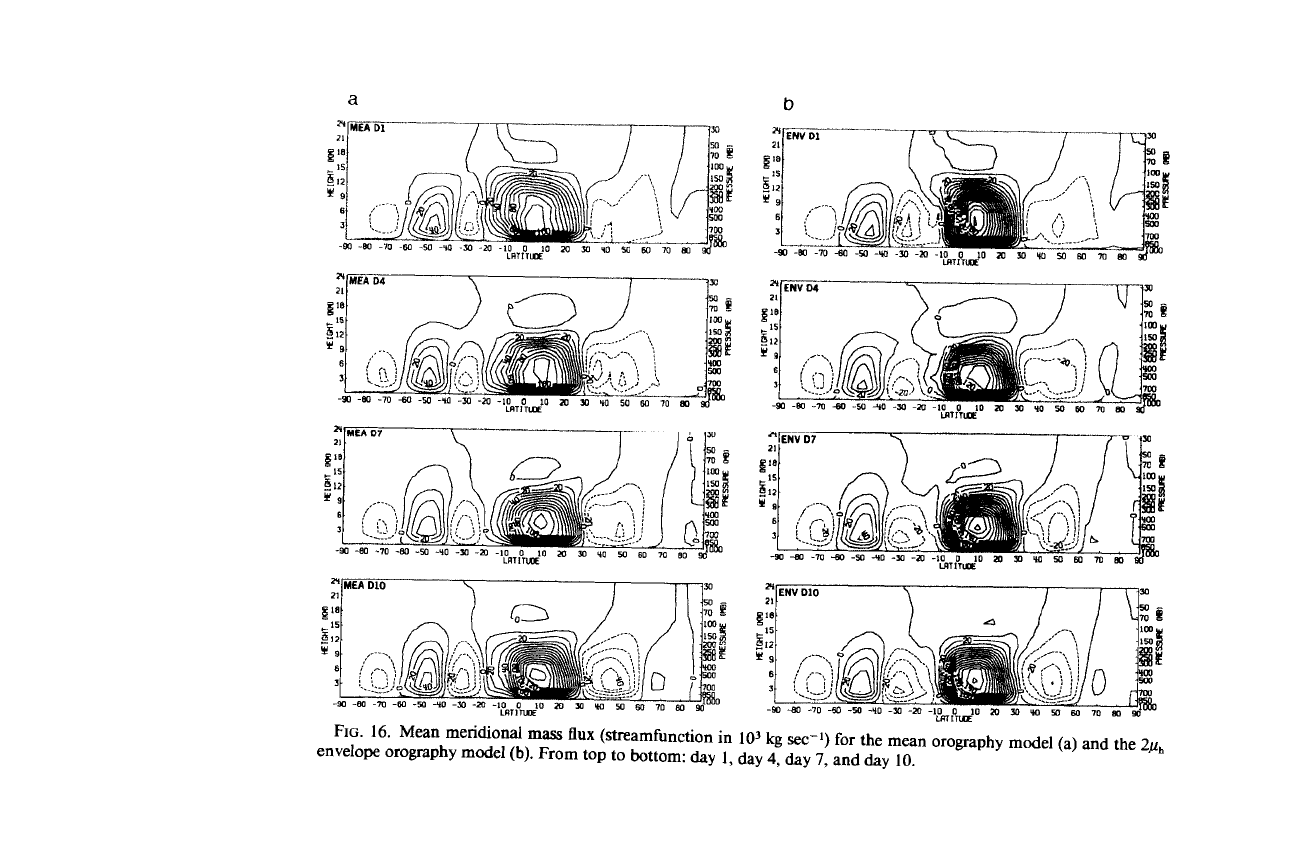
FIG.
16.
Mean meridional
mass
flux
(streamfunction in
lo3
kg
sec-I) for the mean orography model
(a)
and
the
2ph
envelope orography model
(b).
From
top
to bottom:
day
1,
day
4,
day
7,
and
day
10.
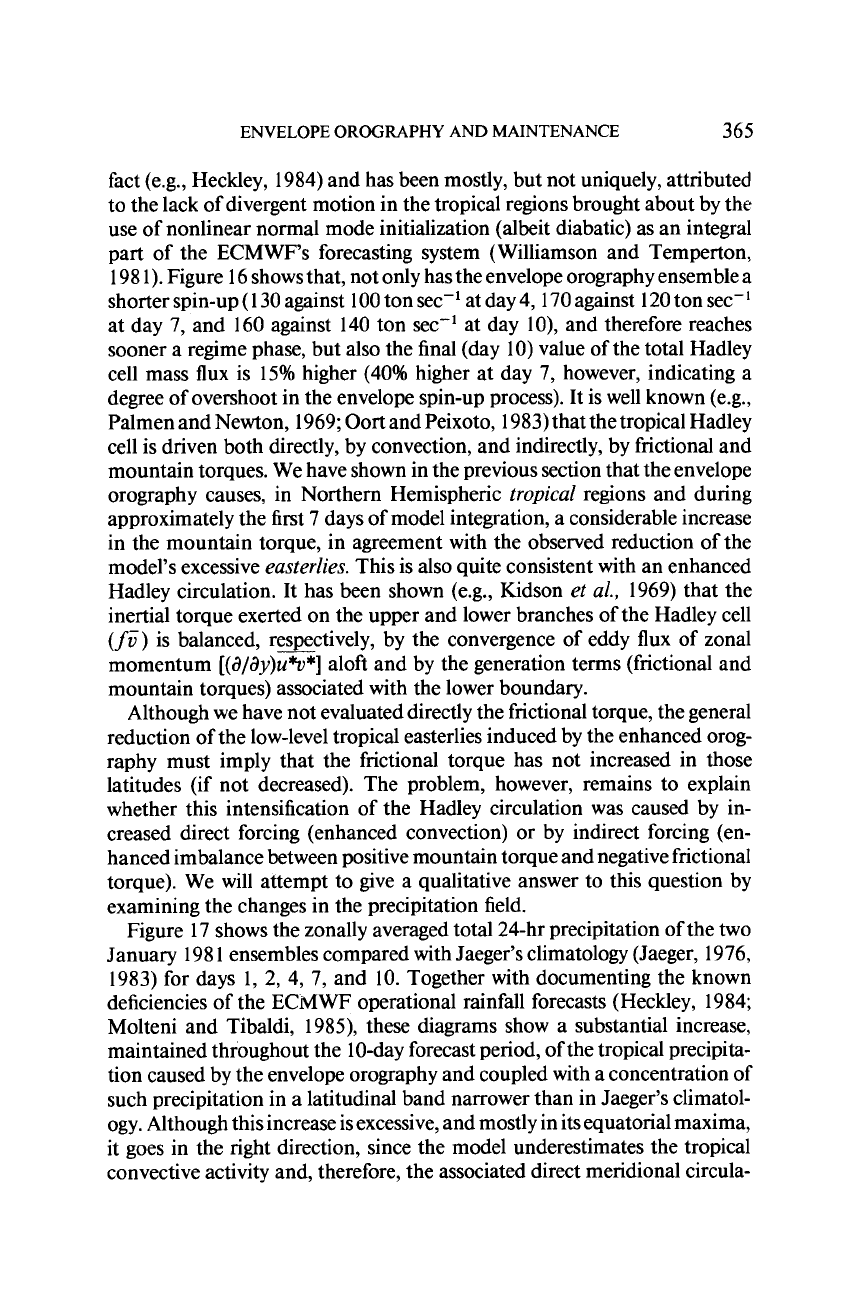
ENVELOPE
OROGRAPHY
AND MAINTENANCE
365
fact (e.g., Heckley,
1984)
and has been mostly, but not uniquely, attributed
to the lack of divergent motion in the tropical regions brought about by the
use of nonlinear normal mode initialization (albeit diabatic) as an integral
part of the ECMWFs forecasting system (Williamson and Temperton,
198
1).
Figure
16
shows that, not only has the envelope orography ensemble a
shorter spin-up
(
130
against
100
ton sec-' at day
4,170
against
120
ton sec-'
at day
7,
and
160
against
140
ton sec-" at day
lo),
and therefore reaches
sooner a regime phase, but also the final (day
10)
value of the total Hadley
cell mass flux is
15%
higher
(40%
higher at day
7,
however, indicating a
degree of overshoot in the envelope spin-up process). It is well known (e.g.,
Palmen and Newton,
1969;
Oort and Peixoto,
1983)
that the tropical Hadley
cell is driven both directly, by convection, and indirectly, by frictional and
mountain torques. We have shown in the previous section that the envelope
orography causes, in Northern Hemispheric
tropical
regions and during
approximately the first
7
days of model integration, a considerable increase
in the mountain torque, in agreement with the observed reduction of the
model's excessive
easterlies.
This is also quite consistent with an enhanced
Hadley circulation. It has been shown (e.g., Kidson
et al.,
1969)
that the
inertial torque exerted on the upper and lower branches of the Hadley cell
(f5)
is balanced, respectively,
-
by the convergence of eddy flux of zonal
momentum
[(d/dy)u%*]
aloft and by the generation terms (frictional and
mountain torques) associated with the lower boundary.
Although we have not evaluated directly the frictional torque, the general
reduction of the low-level tropical easterlies induced by the enhanced orog-
raphy must imply that the frictional torque has not increased in those
latitudes (if not decreased). The problem, however, remains to explain
whether this intensification of the Hadley circulation was caused by in-
creased direct forcing (enhanced convection) or by indirect forcing (en-
hanced imbalance between positive mountain torque and negative frictional
torque). We will attempt to give a qualitative answer to this question by
examining the changes in the precipitation field.
Figure
17
shows the zonally averaged total 24-hr precipitation of the two
January
198
1
ensembles compared with Jaeger's climatology (Jaeger,
1976,
1983)
for days
1,
2,
4, 7,
and
10.
Together with documenting the known
deficiencies of the ECMWF operational rainfall forecasts (Heckley,
1984;
Molteni and Tibaldi,
1985),
these diagrams show a substantial increase,
maintained throughout the
1
0-day forecast period, of the tropical precipita-
tion caused by the envelope orography and coupled with a concentration of
such precipitation in a latitudinal band narrower than in Jaeger's climatol-
ogy. Although this increase is excessive, and mostly in its equatorial maxima,
it goes in the right direction, since the model underestimates the tropical
convective activity and, therefore, the associated direct meridional circula-
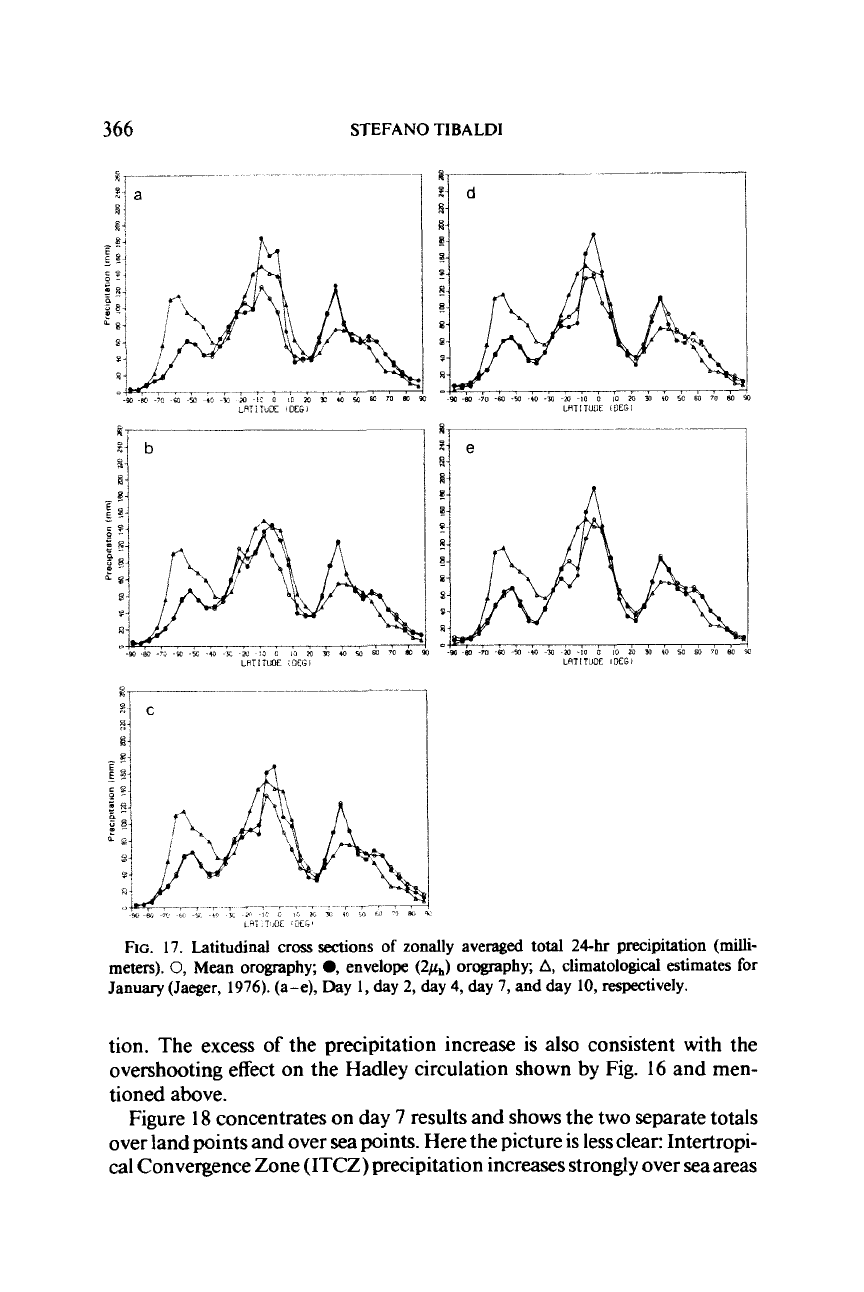
366
STEFAN0 TIBALDI
E
8
8
8
a
LHT
I
TUOE
1
BEG
I
FIG.
17.
Latitudinal cross sections
of
zonally averaged total
24-hr
precipitation (milli-
meters).
0,
Mean orography;
0,
envelope
(2~~)
orography;
A,
climatological estimates
for
January (Jaeger,
1976).
(a-e), Day
1,
day
2,
day
4,
day
7,
and day
10,
respectively.
tion. The excess
of
the precipitation increase is also consistent with the
overshooting effect on the Hadley circulation shown by Fig.
16
and men-
tioned above.
Figure
18
concentrates on day
7
results and shows the two separate totals
over land points and over
sea
points. Here the picture
is
less clear: Intertropi-
cal
Convergence Zone
(ITCZ)
precipitation increases strongly over sea areas
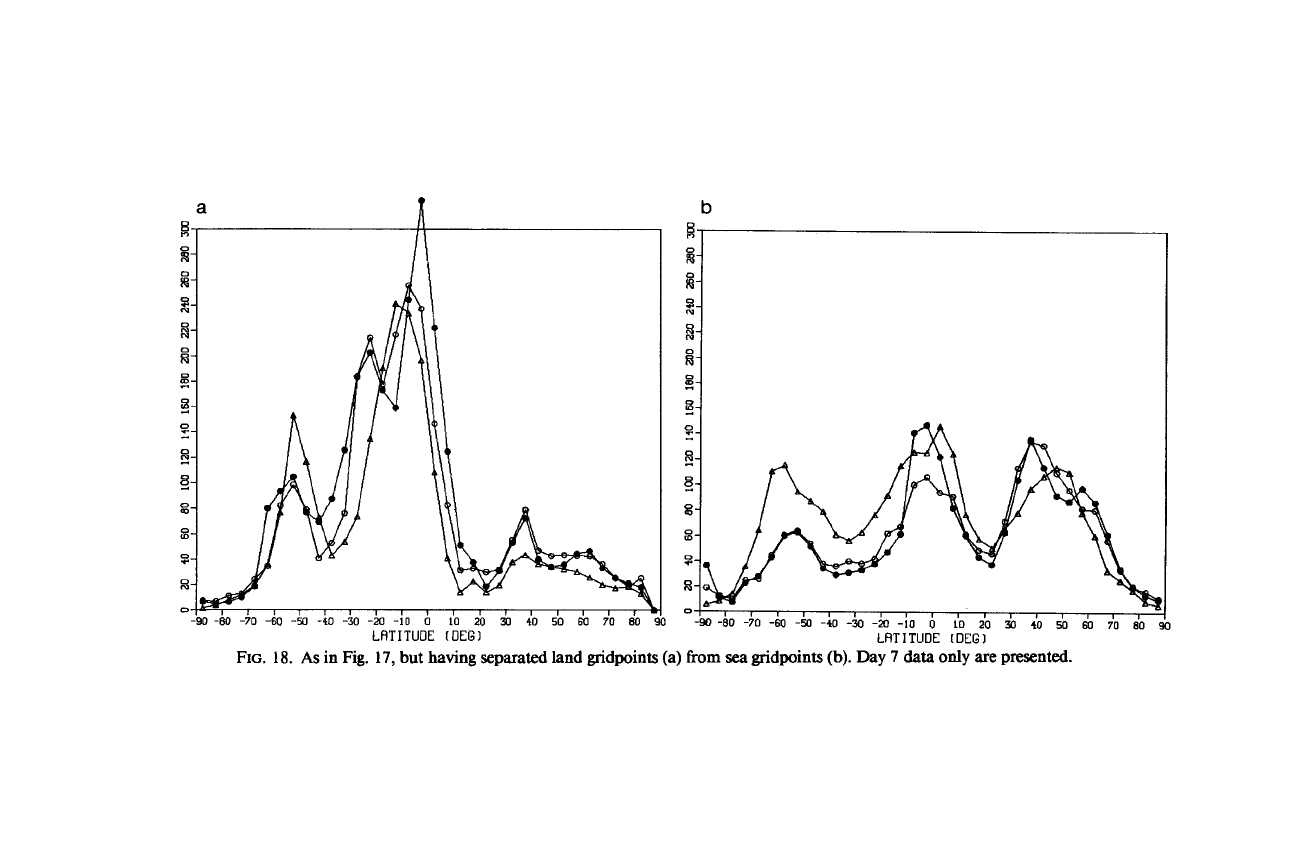
a
w
II
0
R
LATITUDE IDEGI
b
0
N
H
8
0
R
0
LATITUDE
IDEGI
FIG.
18.
As
in
Fig.
17,
but
having
separated
land
gridpoints
(a)
from
sea
gridpoints
(b).
Day
7
data
only are
presented.
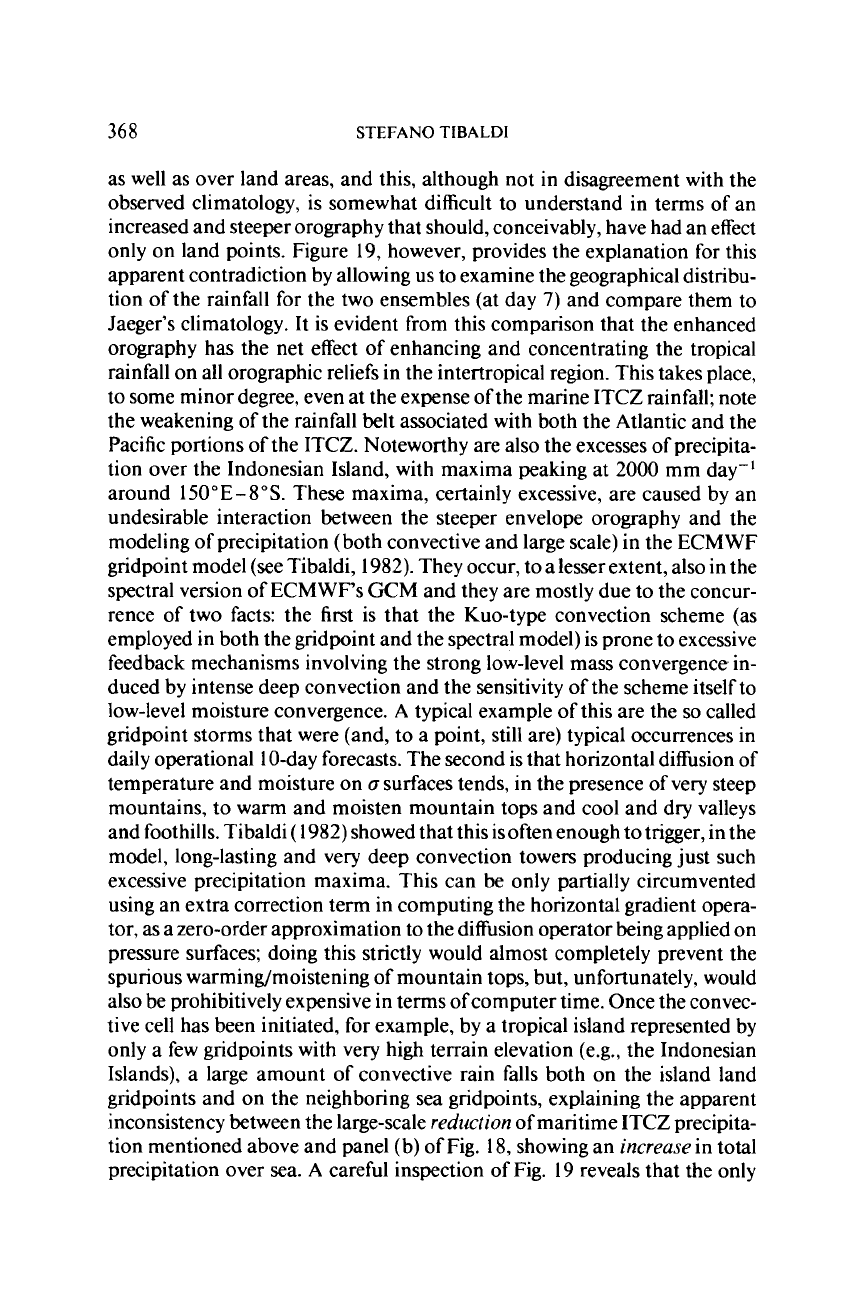
368
STEFAN0
TlBALDl
as well as over land areas, and this, although not in disagreement with the
observed climatology, is somewhat difficult to understand in terms of an
increased and steeper orography that should, conceivably, have had an effect
only on land points. Figure 19, however, provides the explanation for this
apparent contradiction by allowing us to examine the geographical distribu-
tion of the rainfall for the two ensembles (at day
7)
and compare them to
Jaeger's climatology. It is evident from this comparison that the enhanced
orography has the net effect of enhancing and concentrating the tropical
rainfall on all orographic reliefs in the intertropical region. This takes place,
to some minor degree, even at the expense of the marine ITCZ rainfall; note
the weakening
of
the rainfall belt associated with both the Atlantic and the
Pacific portions of the ITCZ. Noteworthy are also the excesses of precipita-
tion over the Indonesian island, with maxima peaking at 2000 mm day-'
around 15O0E-8"S. These maxima, certainly excessive, are caused by an
undesirable interaction between the steeper envelope orography and the
modeling of precipitation (both convective and large scale) in the ECMWF
gridpoint model (see Tibaldi, 1982). They occur, to a lesser extent, also in the
spectral version of ECMWFs GCM and they are mostly due to the concur-
rence of two facts: the first is that the Kuo-type convection scheme (as
employed in both the gridpoint and the spectral model) is prone to excessive
feedback mechanisms involving the strong low-level mass convergence in-
duced by intense deep convection and the sensitivity of the scheme itself to
low-level moisture convergence.
A
typical example of this are the
so
called
gridpoint storms that were (and, to a point, still are) typical occurrences in
daily operational 10-day forecasts. The second is that horizontal diffusion of
temperature and moisture on
0
surfaces tends, in the presence of very steep
mountains, to warm and moisten mountain tops and cool and
dry
valleys
and foothills. Tibaldi
(
1982) showed that this is often enough to trigger, in the
model, long-lasting and very deep convection towers producing just such
excessive precipitation maxima. This can
be
only partially circumvented
using an extra correction term in computing the horizontal gradient opera-
tor, as a zero-order approximation to the diffusion operator being applied on
pressure surfaces; doing this strictly would almost completely prevent the
spurious warming/moistening of mountain tops, but, unfortunately, would
also be prohibitively expensive in terms of computer time. Once the convec-
tive cell has been initiated, for example, by a tropical island represented by
only a few gridpoints with very high terrain elevation (e.g., the Indonesian
Islands), a large amount of convective rain falls both on the island land
gridpoints and on the neighboring sea gridpoints, explaining the apparent
inconsistency between the large-scale
reduction
of maritime ITCZ precipita-
tion mentioned above and panel (b) of Fig. 18, showing an
increase
in total
precipitation over sea. A careful inspection
of
Fig. 19 reveals that the only
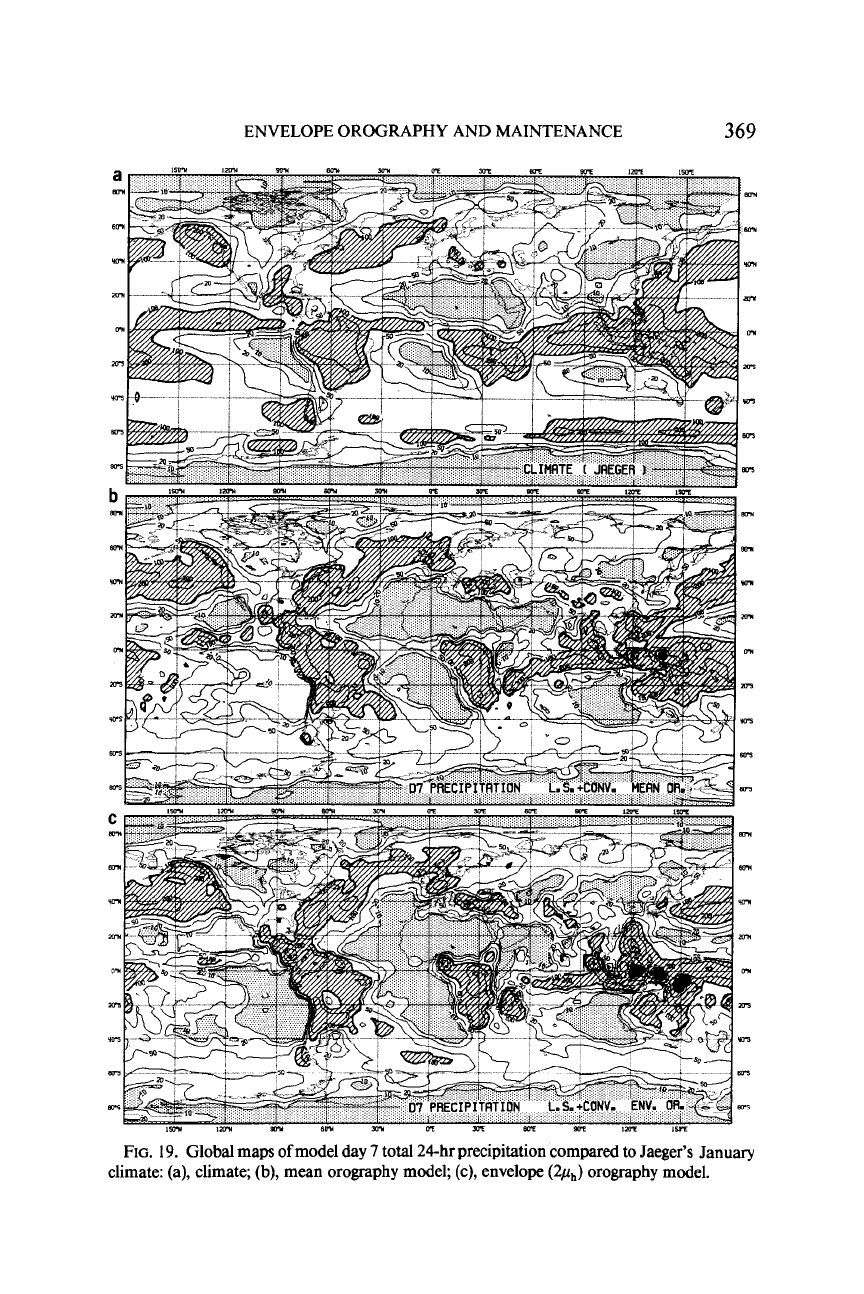
ENVELOPE
OROGRAPHY
AND MAINTENANCE
369
FIG.
19. Global maps
of
model day
7
total 24-hr precipitation
compared
to Jaeger’s January
climate:
(a),
climate; (b), mean orography model; (c), envelope (2j4) orography model.
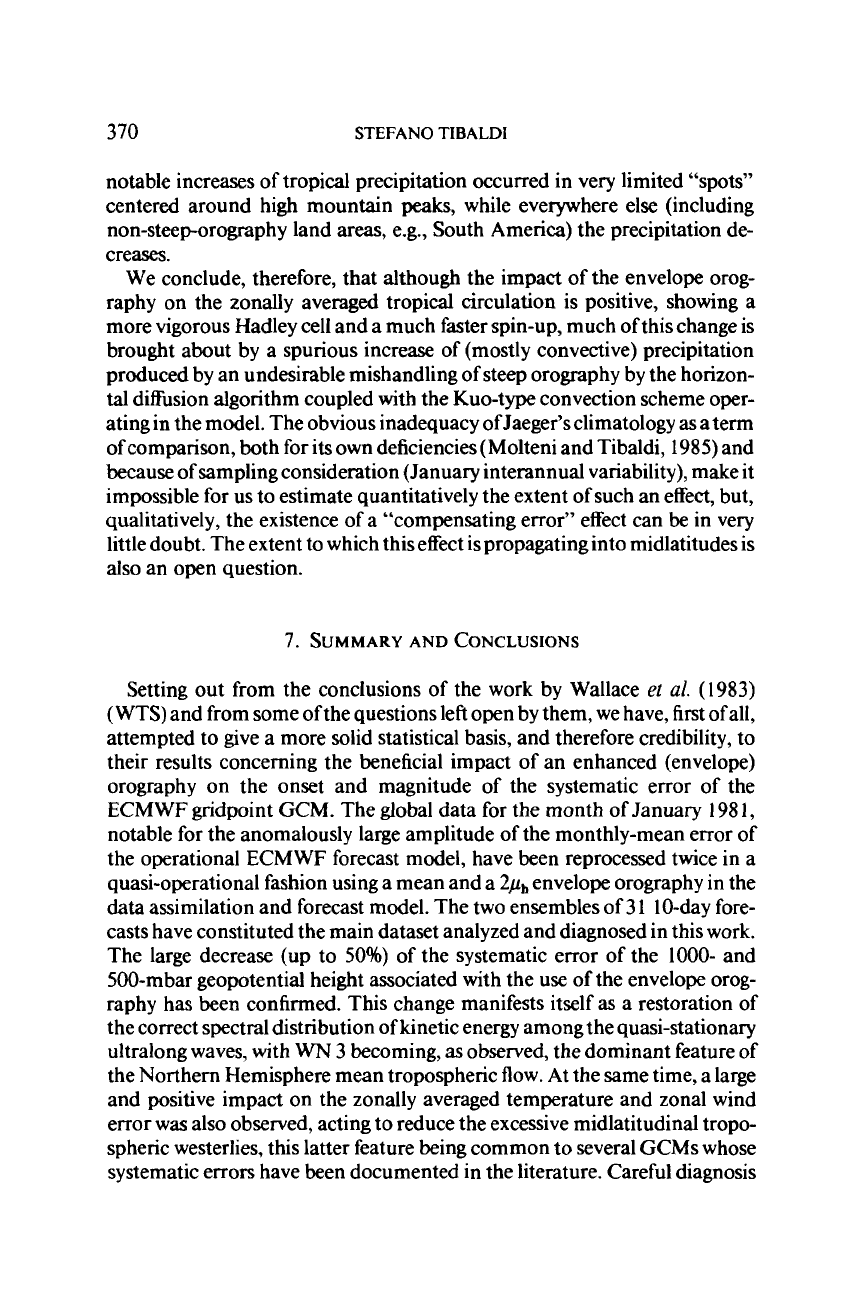
370
STEFAN0
TIBALDI
notable increases of tropical precipitation occurred in very limited “spots”
centered around high mountain
peaks,
while everywhere else (including
non-steep-orography land
areas,
e.g., South America) the precipitation de-
creases.
We conclude, therefore, that although the impact of the envelope orog-
raphy on the zonally averaged tropical circulation is positive, showing a
more vigorous Hadley cell and a much faster spin-up, much ofthis change is
brought about by a spurious increase of (mostly convective) precipitation
produced by an undesirable mishandling of steep orography by the horizon-
tal diffusion algorithm coupled with the Kuo-type convection scheme oper-
ating in the model. The obvious inadequacy ofJaeger’s climatology
as
a term
of comparison, both for its
own
deficiencies (Molteni and Tibaldi,
1985)
and
because of sampling consideration (January interannual variability), make it
impossible for us to estimate quantitatively the extent of such an effect, but,
qualitatively, the existence of a “compensating error” effect can be in very
little doubt. The extent to which this effect is propagating into midlatitudes is
also an open question.
7.
SUMMARY
AND
CONCLUSIONS
Setting out from the conclusions of the work by Wallace
et al.
(1983)
(
WTS) and from some of the questions left open by them, we have, first of all,
attempted to give a more solid statistical basis, and therefore credibility, to
their results concerning the beneficial impact of an enhanced (envelope)
orography on the onset and magnitude of the systematic error of the
ECMWF gridpoint GCM. The global data for the month
of
January
198
I,
notable for the anomalously large amplitude of the monthly-mean error of
the operational ECMWF forecast model, have been reprocessed twice in a
quasi-operational fashion using a mean and a
2ph
envelope orography in the
data
assimilation and forecast model. The two ensembles of
3
I
1
0-day fore-
casts have constituted the main dataset analyzed and diagnosed in this work.
The large decrease (up to
50%)
of the systematic error of the
1000-
and
500-mbar geopotential height associated with the use of the envelope orog-
raphy has been confirmed. This change manifests itself
as
a restoration of
the correct spectral distribution of kinetic energy among the quasi-stationary
ultralong waves, with
WN
3
becoming,
as
observed, the dominant feature of
the Northern Hemisphere mean tropospheric flow. At the same time, a large
and positive impact on the zonally averaged temperature and zonal wind
error was also observed, acting to reduce the excessive midlatitudinal tropo-
spheric westerlies, this latter feature being common to several GCMs whose
systematic errors have been documented in the literature. Careful diagnosis
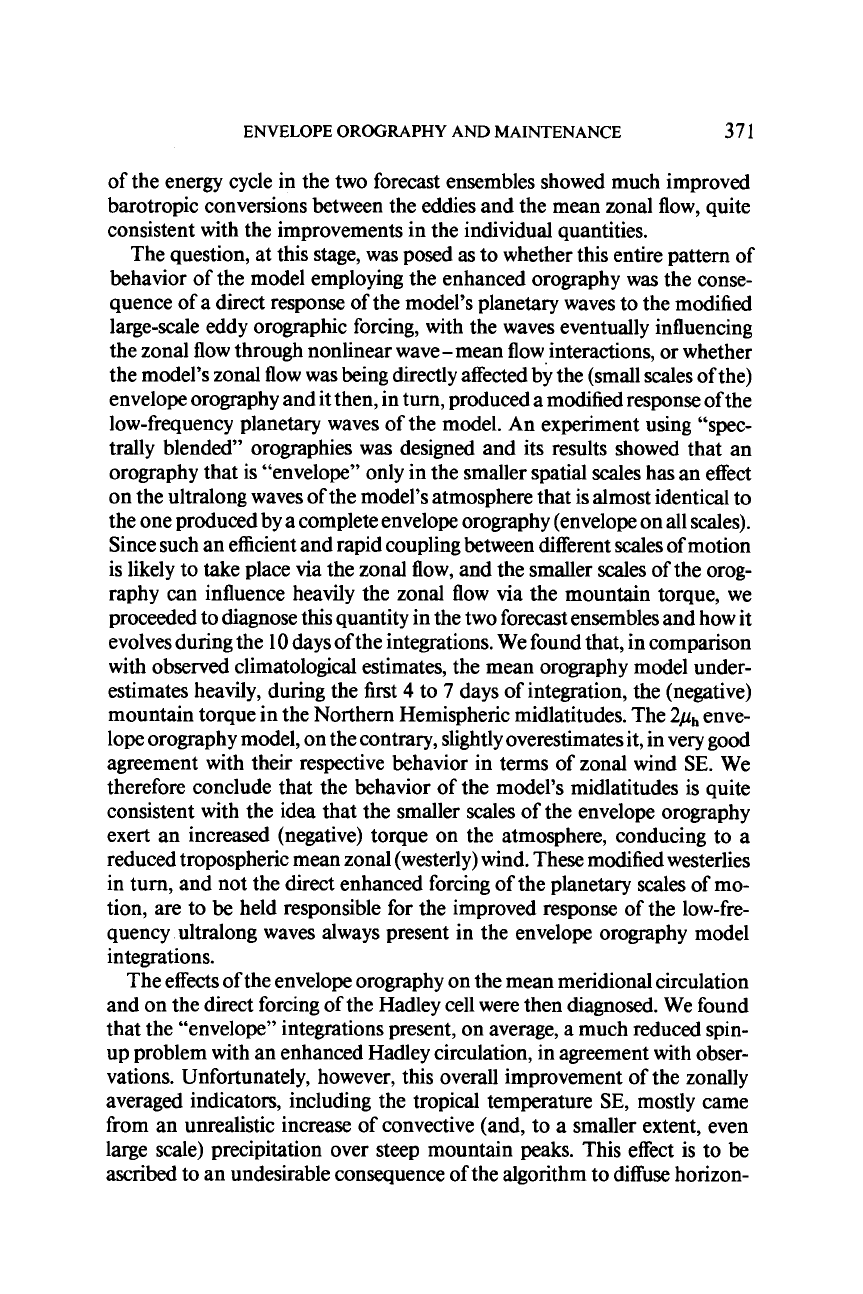
ENVELOPE
OROGRAPHY
AND MAINTENANCE
371
of the energy cycle in the two forecast ensembles showed much improved
barotropic conversions between the eddies and the mean zonal flow, quite
consistent with the improvements in the individual quantities.
The question, at this stage, was posed as to whether this entire pattern of
behavior of the model employing the enhanced orography was the conse-
quence of a direct response of the model’s planetary waves to the modified
large-scale eddy orographic forcing, with the waves eventually influencing
the zonal flow through nonlinear wave- mean flow interactions, or whether
the model’s zonal flow was being directly affected by the (small scales of the)
envelope orography and it then, in turn, produced a modified response of the
low-frequency planetary waves of the model. An experiment using “spec-
trally blended” orographies was designed and its results showed that an
orography that is “envelope” only in the smaller spatial scales has an effect
on the ultralong waves of the model’s atmosphere that is almost identical to
the one produced by a complete envelope orography (envelope on all scales).
Since such an efficient and rapid coupling between different scales of motion
is likely to take place via the zonal flow, and the smaller scales of the orog-
raphy can influence heavily the zonal flow via the mountain torque, we
proceeded to diagnose this quantity in the two forecast ensembles and how it
evolves during the
10
days of the integrations. We found that, in comparison
with observed climatological estimates, the mean orography model under-
estimates heavily, during the first
4
to
7
days of integration, the (negative)
mountain torque in the Northern Hemispheric midlatitudes. The
2ph
enve-
lope orography model, on the contrary, slightly overestimates it, in very good
agreement with their respective behavior in terms of zonal wind
SE.
We
therefore conclude that the behavior of the model’s midlatitudes is quite
consistent with the idea that the smaller scales of the envelope orography
exert an increased (negative) torque on the atmosphere, conducing to a
reduced tropospheric mean zonal (westerly) wind. These modified westerlies
in turn, and not the direct enhanced forcing of the planetary scales
of
mo-
tion, are to be held responsible for the improved response of the low-fre-
quency ultralong waves always present in the envelope orography model
integrations.
The effects of the envelope orography on the mean meridional circulation
and on the direct forcing of the Hadley cell were then diagnosed. We found
that the “envelope” integrations present, on average, a much reduced spin-
up problem with an enhanced Hadley circulation, in agreement with obser-
vations. Unfortunately, however, this overall improvement of the zonally
averaged indicators, including the tropical temperature
SE,
mostly came
from an unrealistic increase of convective (and, to a smaller extent, even
large scale) precipitation over steep mountain peaks. This effect is to be
ascribed to an undesirable consequence
of
the algorithm to diffuse horizon-
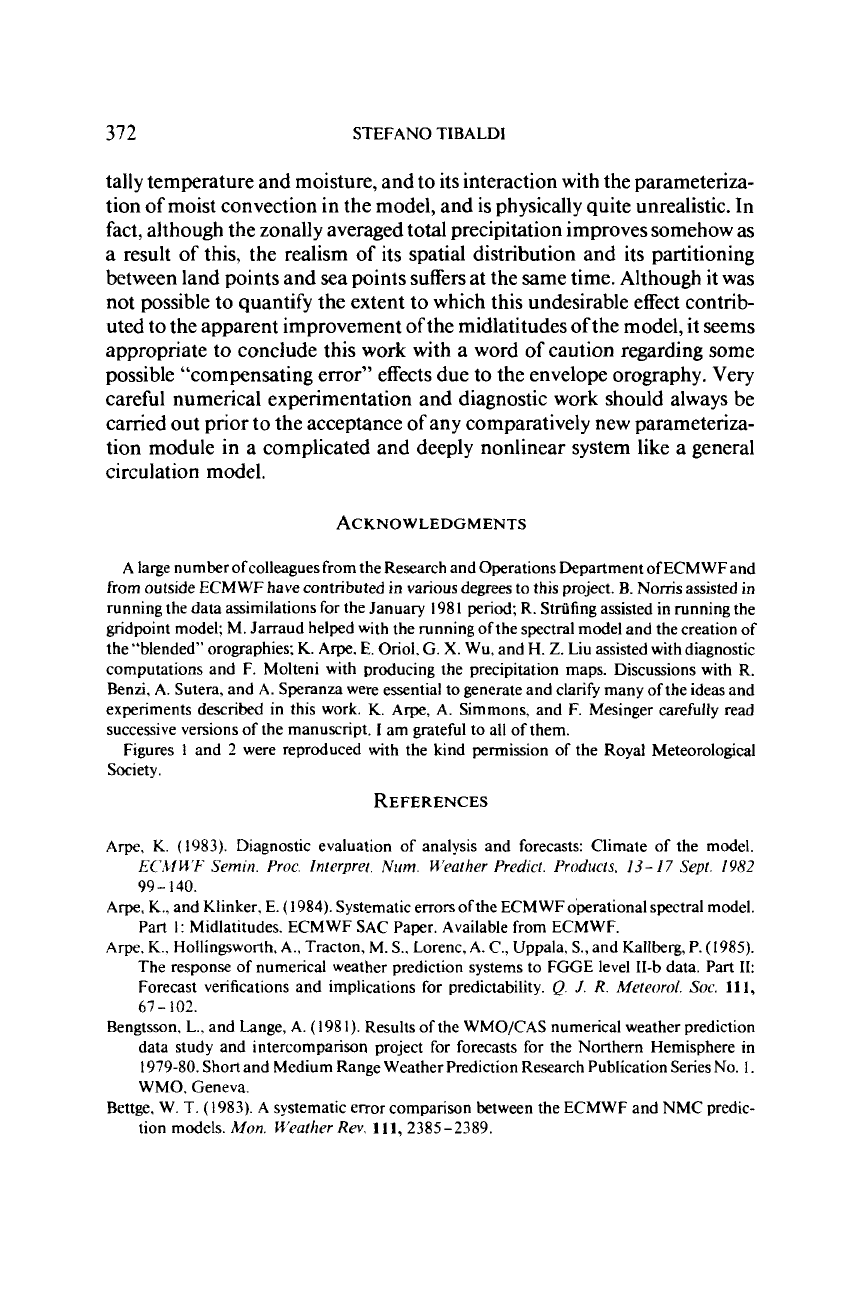
372
STEFAN0 TIBALDI
tally temperature and moisture, and to its interaction with the parameteriza-
tion
of
moist convection in the model, and
is
physically quite unrealistic. In
fact, although the zonally averaged total precipitation improves somehow as
a result
of
this, the realism of its spatial distribution and its partitioning
between land points and sea points suffers at the same time. Although it was
not possible to quantify the extent to which this undesirable effect contrib-
uted to the apparent improvement
of
the midlatitudes
of
the model, it seems
appropriate
to
conclude this work with a word of caution regarding some
possible “compensating error” effects due to the envelope orography. Very
careful numerical experimentation and diagnostic work should always be
carried out prior to the acceptance
of
any comparatively new parameteriza-
tion module in a complicated and deeply nonlinear system like a general
circulation model.
ACKNOWLEDGMENTS
A
large number ofcolleagues from the Research and Operations Department ofECMWFand
from outside ECMWF have contributed in various degrees to this project.
B.
Noms
assisted in
running the data assimilations for the January
198
I
period; R. Striifing assisted in running the
gridpoint model: M. Jarraud helped with the running ofthe spectral model and the creation of
the “blended” orographies;
K.
Arpe.
E.
Oriol.
G.
X.
Wu, and
H.
Z.
Liu assisted with diagnostic
computations and F. Molteni with producing the precipitation maps. Discussions with
R.
Benzi, A. Sutera, and A. Speranza were essential to generate and clarify many
of
the ideas and
experiments described in this work.
K.
Arpe, A. Simmons, and
F.
Mesinger carefully read
successive versions of the manuscript.
I
am grateful to all of them.
Figures
1
and
2
were reproduced with the kind permission of the Royal Meteorological
Society.
REFERENCES
Arpe.
K.
(1983).
Diagnostic evaluation of analysis and forecasts: Climate of the model.
EC’M
M%‘
Semin. Proc. Interpret.
Nicm.
U‘eather Predict. Products,
13-
I7
Sept.
I982
Ape.
K., and Klinker.
E.
(1984).
Systematic errors ofthe ECMWFoperational spectral model.
Part
I
:
Midlatitudes. ECMWF SAC Paper. Available from ECMWF.
Arpe.
K.,
Hollingsworth.
A,,
Tracton, M.
S..
Lorenc,
A.
C.,
Uppala,
S.,
and Kallberg,
P.
(1985).
The
response of numerical weather prediction systems to FGGE level 11-b data. Part
11:
Forecast verifications and implications for predictability.
Q.
J.
R.
Mc>teorol.
Soc.
11
1,
67-
102.
Bengtsson,
L.,
and Lange, A.
(I98
I).
Results of the WMO/CAS numerical weather prediction
data study and intercomparison project for forecasts for the Northern Hemisphere in
1979-80.
Short and Medium Range Weather Prediction Research Publication Series
No.
1.
WMO, Geneva.
Bettge.
W.
T.
(1983).
A
systematic error comparison between the ECMWF and NMC predic-
tion models.
Mon.
A’ealher Rev.
111,2385-2389.
99-
140.
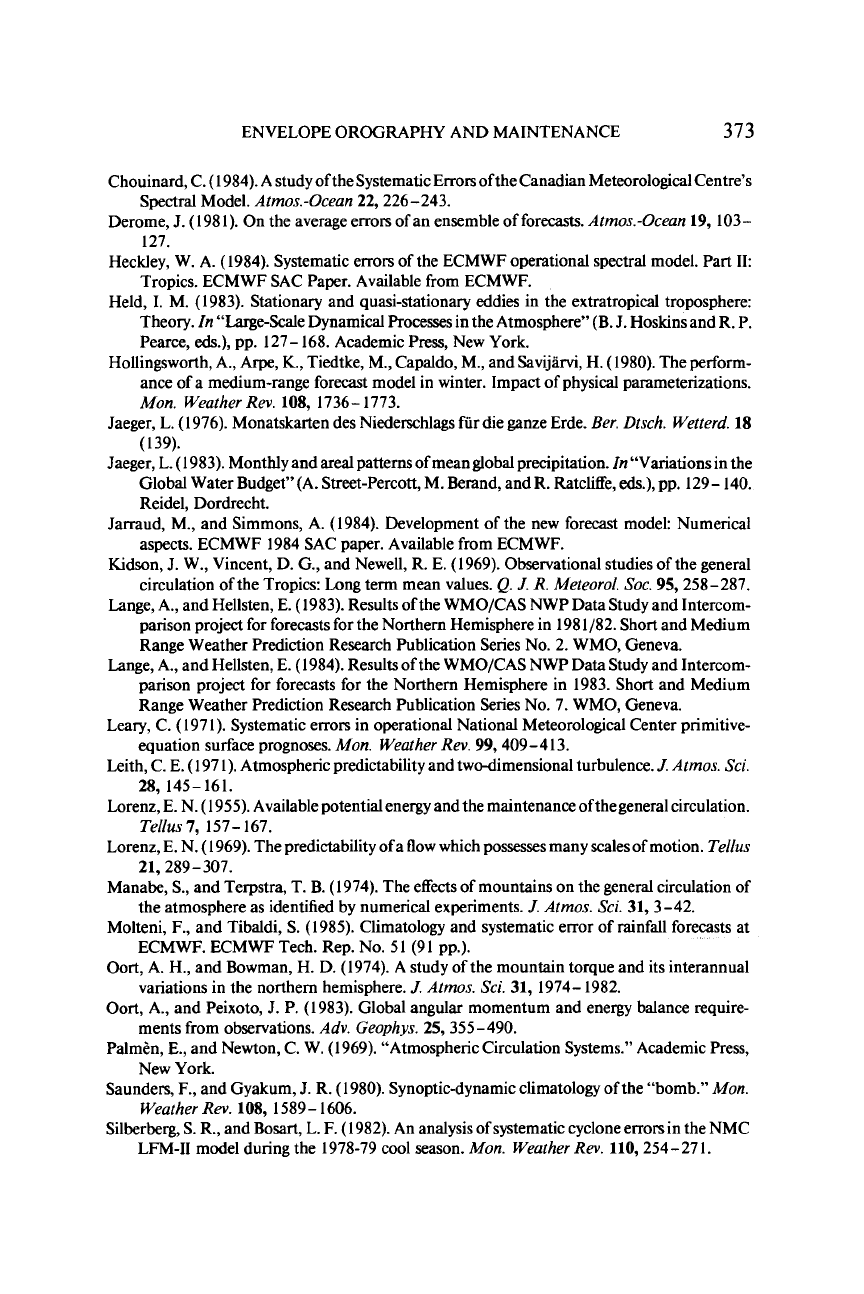
ENVELOPE OROGRAPHY AND MAINTENANCE
373
Chouinard, C.
(
1984).
A
study of the Systematic Errorsofthe Canadian Meteorological Centre’s
Spectral Model.
Atmos.-Ocean
22,226-243.
Derome, J.
(198
1).
On the average errors of an ensemble of forecasts.
Amos.-Ocean
19, 103-
127.
Heckley, W.
A.
(1984).
Systematic errors of the ECMWF operational spectral model. Part 11:
Tropics. ECMWF SAC Paper. Available from ECMWF.
Held,
I.
M.
(1983).
Stationary and quasi-stationary eddies in the extratropical troposphere:
Theory.
In
“Large-Scale Dynamical
Processes
in the Atmosphere” (B. J. Hoskins and R. P.
Pearce,
eds.),
pp.
127- 168.
Academic Press, New York.
Hollingsworth, A., Arpe,
K.,
Tiedtke, M., Capaldo,
M.,
and Savijarvi, H.
(1980).
The perform-
ance of a medium-range forecast model in winter. Impact of physical parameterizations.
Mon.
Weather Rev.
108, 1736- 1773.
Jaeger, L.
(1
976).
Monatskarten des Niederschlags fur die ganze Erde.
Ber. Dtsch. Wetterd.
18
(1
39).
Jaeger, L.
(
1983).
Monthly and areal patterns of mean global precipitation.
In
“Variationsin the
Global Water Budget”(A. Street-Percott,
M.
Berand, and R. Ratcliffe,
eds.),
pp.
129- 140.
Reidel, Dordrecht.
Jarraud, M., and Simmons, A.
(1984).
Development of the new forecast model: Numerical
aspects. ECMWF
1984
SAC paper. Available from ECMWF.
Kidson,
J.
W., Vincent, D.
G.,
and Newell, R. E.
(1969).
Observational studies of the general
circulation ofthe Tropics: Long term mean values.
Q.
J.
R. Meteorol.
SOC.
95,258-287.
Lange, A., and Hellsten, E.
(1983).
Results of the WMO/CAS NWP Data Study and Intercom-
parison project
for
forecasts for the Northern Hemisphere in
198 1/82.
Short and Medium
Range Weather Prediction Research Publication Series No.
2.
WMO, Geneva.
Lange, A., and Hellsten, E.
(I
984).
Results of the WMO/CAS NWP Data Study and Intercom-
parison project
for
forecasts for the Northern Hemisphere in
1983.
Short and Medium
Range Weather Prediction Research Publication Series No.
7.
WMO, Geneva.
Leary, C.
(197
1).
Systematic errors in operational National Meteorological Center primitive-
equation surface prognoses.
Mon. Weather Rev.
99,409-41 3.
kith, C. E.
(1
97
1).
Atmospheric predictability and two-dimensional turbulence.
J.
Atrnos.
Sci.
Lorenz, E. N.
(I
955).
Available potential energy and the maintenance ofthegeneral circulation.
Lorenz, E. N.
(
1969).
The predictability
of
a flow which possesses many scales of motion.
Tellus
Manabe,
S.,
and Terpstra,
T.
B.
(1
974).
The effects of mountains on the general circulation of
the atmosphere as identified by numerical experiments.
J.
Atmos.
Sci.
31,3-42.
Molteni, F., and Tibaldi,
S.
(1985).
Climatology and systematic error of rainfall forecasts at
ECMWF. ECMWF Tech. Rep.
No.
5
1
(9
1
pp.).
Oort, A. H., and Bowman, H. D.
(1974).
A study
of
the mountain torque and its interannual
variations in the northern hemisphere.
J.
Atmos.
Sci.
31, 1974- 1982.
Oort, A., and Peixoto,
J.
P.
(I
983).
Global angular momentum and energy balance require-
ments from observations.
Adv. Geophys.
25,355-490.
Palmen, E., and Newton, C. W.
(1969).
“Atmospheric Circulation Systems.” Academic Press,
New York.
Saunders, F., and Gyakum,
J.
R.
(1980).
Synoptic-dynamic climatology of the “bomb.”
Mon.
Weather Rev.
108, 1589- 1606.
Silberberg,
S.
R., and Bosart, L.
F.
(
1982).
An analysis of systematic cyclone errors in the NMC
LFM-I1 model during the
1978-79
cool season.
Mon.
Weather Rev.
110,254
-
27
I.
28, 145-161.
Tellus
7,
157- 167.
21,289-307.
